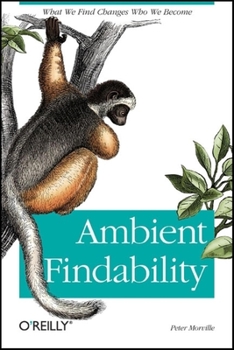Ambient Findability
Select Format
Select Condition 
Book Overview
Morville discusses the Internet, GIS, and other network technologies that are coming together to make unlimited findability possible. He explores how the melding of these innovations impacts society, since Web access is now a standard requirement for successful people and businesses. But before he does that, Morville looks back at the history of wayfinding and human evolution, suggesting that our fear of being lost has driven us to create maps, charts, and now, the mobile Internet.
The book's central thesis is that information literacy, information architecture, and usability are all critical components of this new world order. Hand in hand with that is the contention that only by planning and designing the best possible software, devices, and Internet, will we be able to maintain this connectivity in the future. Morville's book is highlighted with full color illustrations and rich examples that bring his prose to life.
Ambient Findability doesn't preach or pretend to know all the answers. Instead, it presents research, stories, and examples in support of its novel ideas. Are we truly at a critical point in our evolution where the quality of our digital networks will dictate how we behave as a species? Is findability indeed the primary key to a successful global marketplace in the 21st century and beyond. Peter Morville takes you on a thought-provoking tour of these memes and more -- ideas that will not only fascinate but will stir your creativity in practical ways that you can apply to your work immediately.
"A lively, enjoyable and informative tour of a topic that's only going to become more important."
--David Weinberger, Author, Small Pieces Loosely Joined and The Cluetrain Manifesto
"I envy the young scholar who finds this inventive book, by whatever strange means are necessary. The future isn't just unwritten--it's unsearched."
--Bruce Sterling, Writer, Futurist, and Co-Founder, The Electronic Frontier Foundation
"Search engine marketing is the hottest thing in Internet business, and deservedly so. Ambient Findability puts SEM into a broader context and provides deeper insights into human behavior. This book will help you grow your online business in a world where being found is not at all certain."
--Jakob Nielsen, Ph.D., Author, Designing Web Usability: The Practice of Simplicity
"Information that's hard to find will remain information that's hardly found--from one of the fathers of the discipline of information architecture, and one of its most experienced practitioners, come penetrating observations on why findability is elusive and how the act of seeking changes us."
--Steve Papa, Founder and Chairman, Endeca
"Whether it's a fact or a figure, a person or a place, Peter Morville knows how to make it findable. Morville explores the possibilities of a world where everything can always be found--and the challenges in getting there--in this wide-ranging, thought-provoking book."
--Jesse James Garrett, Author, The Elements of User Experience
"It is easy to assume that current searching of the World Wide Web is the last word in finding and using information. Peter Morville shows us that search engines are just the beginning. Skillfully weaving together information science research with his own extensive experience, he develops for the reader a feeling for the near future when information is truly findable all around us. There are immense implications, and Morville's lively and humorous writing brings them home."
--Marcia J. Bates, Ph.D., University of California Los Angeles
"I've always known that Peter Morville was smart. After reading Ambient Findability, I now know he's (as we say in Boston) wicked smart. This is a timely book that will have lasting effects on how we create our future.
--Jared Spool, Founding Principal, User Interface Engineering
"In Ambient Findability, Peter Morville has put his mind and keyboard on the pulse of the electronic noosphere. With tangible examples and lively writing, he lays out the challenges and wonders of finding our way in cyberspace, and explains the mutually dependent evolution of our changing world and selves. This is a must read for everyone and a practical guide for designers."
--Gary Marchionini, Ph.D., University of North Carolina
"Find this book Anyone interested in making information easier to find, or understanding how finding and being found is changing, will find this thoroughly researched, engagingly written, literate, insightful and very, very cool book well worth their time. Myriad examples from rich and varied domains and a valuable idea on nearly every page. Fun to read, too
--Joseph Janes, Ph.D., Founder, Internet Public Library





